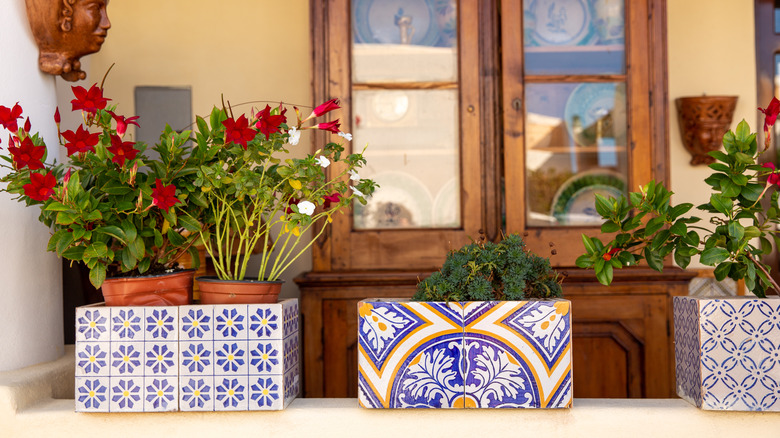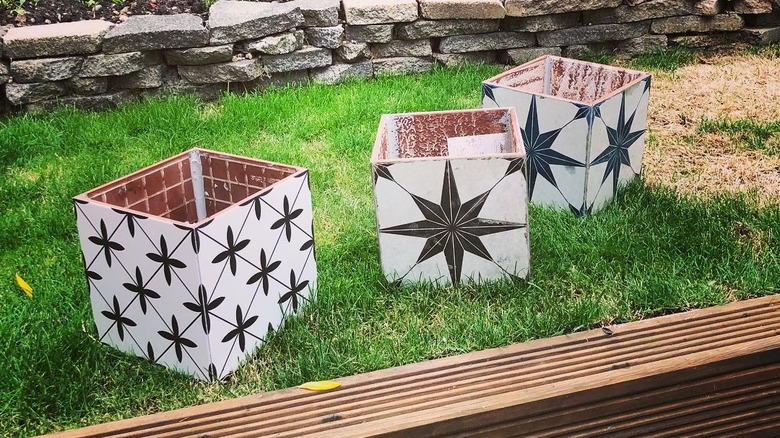How To DIY A Planter Out Of Old Tile
Looking to add a unique personal touch to your garden or balcony? Well, dust off those old tiles and get ready to create a fabulous planter that'll outshine any planter from your local hardware store. Not only will you be repurposing materials, but you'll also be giving your plants a stylish new home. Some things you'll need to get started on your DIY tile planter are a clean, empty two-liter bottle, patterned tiles, heavy-duty or craft glue, scissors, pebbles or gravel, and a bradawl tool, used for precise non-slip drilling. With just these few materials, you'll have a brand new planter for your small plant babies.
DIYing your own planter also comes with several significant benefits for your plants. First off, since you'll be creating the planter yourself, you can customize the drainage system to meet your plants' moisture needs. Excellent drainage is paramount to avoiding root rot and other moisture-related diseases. Furthermore, tiles can help regulate the soil temperature, unlike traditional plastic pots.
The thermal stability will also foster desirable root growth, improving plant health. Lastly, since tiles are designed for high-traffic spaces, they are durable and should withstand the test of time and the elements, providing both longevity and durability for any plant friends who make a home there.
Creating the base
Clear a space in your work area and arrange the selected tiles to form the desired size and shape for your planter base. Once you're happy with the tile arrangement, use a strong adhesive like E6000 or Weldbond to attach the tiles firmly together. Apply the adhesive to the edges and press the tiles together. Create the perimeter of the planter first and then attach it to a face-down tile that's supposed to serve as the bottom of the planter. Let it dry according to the adhesive's instructions.
There are two methods to create adequate drainage holes for your planter. The first method involves the plastic bottle. While the planter dries, trim the top of the two-liter bottle so it is just shy of the height of the planter. The bottle will serve as the container for the soil while the planter will be the decorative exterior. In this way, you'll be able to remove the plastic component to water the plant in a sink or outside. Use the bradawl to create holes in the bottom of the plastic bottle for water to escape.
Alternatively, if you are handy and own a diamond drill bit, you could carefully drill drainage holes directly into the bottom tile and forgo the plastic bottle insert. Drill the bottom tile before attaching it to the perimeter pieces to avoid any breakage or injuries. With this method, plants can be grown directly in the planter itself without needing a plastic liner.
Soil and plant selection
When selecting soil, keep your desired plant in mind. If you plan on having succulents, a cacti mix that has coarse sand or pumice will be best in order to mimic their native soil conditions. Otherwise, a well-draining all-purpose potting soil will suffice. Look for mixes specifically labeled as "well-draining" or "for containers."
These mixes typically contain a blend of materials like peat moss, perlite, and vermiculite, which promote good drainage while retaining sufficient moisture. If you plan to use the pot for herbs or vegetables, consider adding some compost or organic matter in order to fertilize the plants for optimal growth and harvest.
Succulents and cacti are some of the best plants for your DIY tile planter. These are low-maintenance plants that do not require frequent watering. Choose varieties like echeveria, sedum, or aloe, which have shallow root systems and can withstand drier conditions. Other great compact options are herbs. Pop your planter on your kitchen counter and fill it with herbs like basil, rosemary, or thyme, which are well-suited to containers and offer fresh flavors and aromatics to your kitchen.
Lastly, take advantage of the vertical space of your tile planter by selecting trailing or cascading plants. Varieties like trailing ivy, creeping Jenny, or trailing petunias create a stunning display as they spill over the planter's edges, adding a touch of whimsy and beauty to your new planter.

